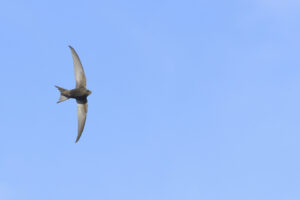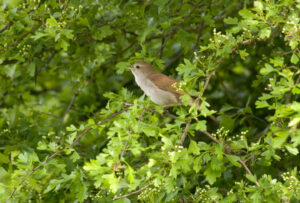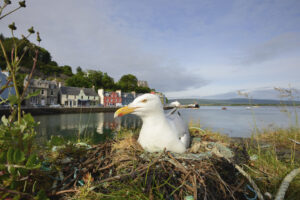Broads Uncovered: Summer Migrants and the Dawn Chorus

One of the most exciting signs that spring is here to stay is the reappearance of the summer migrant birds, like swallows and terns, back from their overwintering grounds far South of Europe. Luckily for them the open water, reed, fen, grazing marsh and wet woodland (carr) habitats of the Broads National Park provide a bountiful supply of food. Plentiful food throughout the summer means the migrants return here each year and join the non-migrating (resident) birds setting up territories, attracting mates and raising their chicks before preparing for the long journey south in the late summer and autumn.
The Spring Migration
Migration is a dangerous business. There are the natural threats like bad weather blowing birds off course, mountain ranges, like the Pyrenees, to fly over and that massive beastie the Sahara Desert to cross! Then there are the mounting threats caused by humans: rest and re-fuelling sites are built on or drained, birds get shot at or caught and the Sahara Desert is getting even bigger due to desertification. To protect birds from these growing threats and halt their population declines requires co-operation between the many countries along the birds’ routes. The Ramsar Convention on Wetlands was one of the first intergovernmental treaties established to protect wetland habitats, which are important for many migrating birds. Breydon Water, in the Broads National Park, is a designated Ramsar site and is managed by the Royal Society for the Protection of Birds (RSPB).
Achieving international co-operation is no easy task for conservation organisations and is made more difficult by our limited knowledge of which routes the migrating birds take. Luckily with the development of ultra-light new tracking technology many of these unknowns are being answered helping to improve our ability to protect migratory birds on their fantastic journeys.
Our Migrant “Big 5” that can be seen in the Broads National Park

1. First up is the Swallow because, in folklore, it’s arrival heralds the start of spring. The abundant insect life throughout the Broads National Park attracts swallows to the region from April onwards. They can be seen skilfully manoeuvring through the air above the broads catching any flying insect that is near. They even drink while flying! Once their chicks have fledged, the swallows move from their nest sites to roost in flocks in the reed beds flanking the Park’s broads and rivers as they fatten up ready for their flight back to Africa.
Here is some great footage from BBC Earth Flight of swallow flocks in the reedbeds of South Africa. Click here to watch

2. Next up is the fish eating Osprey. Although we have no breeding osprey in the Broads National Park they do visit the area with the odd non-breeding individual staying for the summer. Female Osprey arrive in late March in the U.K. (ahead of the males) having flown up from West Africa directly over the Sahara Desert. Osprey were extinct in the U.K. by 1920 due to human persecution. They are a great example of a migratory species having initially gone extinct from part of its range and then returning naturally as conditions improved. Migrants passing on their way to breeding sites in Scandinavia began breeding again in Scotland for the first time in 1959. Since then further human led re-introductions have helped see their numbers rise.
Watch via WebCam the Osprey pair on their nest at Rutland Water. Click here to watch.

3. Possibly the most fascinating summer migrant is the Cuckoo. Not only are they brood parasites (laying their eggs in other bird’s nests for them to rear) but it was only recently discovered where they go in winter – the forests of the Congo. In the Broads National Park, cuckoos lay their eggs in the nests of reed warblers, amongst the reeds, and meadow pipit nests out on the grazing marshes. It takes the female only 10 seconds to lay her egg and she can lay up to 25 eggs in a summer!
Cuckoo numbers have declined by 65% in the last 40 years in England but this decline has been less in Scotland and Wales. Through the British Trust for Ornithology (BTO)’s Cuckoo Tracking project, which makes use of ultra-light GPS tags attached to cuckoos, a potential reason for this difference was uncovered. All the cuckoos have to fly over the Sahara Desert (it takes them 50-60 hours of non-stop flying) and they need to be well fed and watered to make it to the other side. However, English cuckoos migrate south via Spain which has been suffering from drought and wild fires. This may have affected the Cuckoos ability to feed causing them to struggle to cross the desert. Scottish and Welsh cuckoos on the other hand go via Italy where these factors were not an issue and more of them survived the desert crossing.
In 2018, “Carlton II” one of the BTO’s tracked cuckoos was tagged in the Broads National Park at Carlton Marshes Nature Reserve and tracked by the Cuckoo Tracking Project. Click here to see this year’s cuckoos migration journeys.

4. Seabirds such as terns are also migrants and the Little Tern is our choice for Migrant #4. It’s one of Britain’s rarest seabirds and the smallest, weighing only 40-60g! Little Terns arrive back on U.K. shores in April and May from West Africa. They breed in some coastal areas of the Broads National Park and can be seen whirling and diving into the sea to catch fish.
Migrating birds don’t just face threats on their journeys they also face them at their breeding grounds and this is the case for the Little Tern. Terns lay their eggs directly on shingle or sand beaches relying purely on camouflage to protect their eggs and chicks from predators. This means their eggs and chicks are vulnerable to predators as well as disturbance from humans and dogs. If you visit the coast with your much-loved family dog, near Little Tern nesting grounds, please follow the onsite advice and just keep them on the lead at the crucial breeding time. This is from May to July. Find out more about Little Terns here.

5. Last but by no means least, the Swift. They are one of the last migrants to arrive and the first to leave but they aren’t slow! These speedsters can hit speeds of 69.3mph. Move over peregrine, these are amongst the fastest birds getting no help from gravity! When they migrate to and from either central or South Africa they travel 800km a day and will, over their lifespan, fly a staggering 2 million km. These lords and ladies of the air do everything while flying – mate, eat, drink and sleep! The only thing they don’t do while in the air is incubate their eggs.
Swifts arrive in the Broads National Park in April and May where they and their chicks happily consume 10 000 insects a day. Like the Little Tern, their numbers have dropped because of threats at their breeding grounds. These threats are loss of nesting sites and a drop in insect numbers due to insecticides. Swifts mate for life and return to the same nest site each year. They particularly like old buildings which means if these buildings are demolished or renovated they return to find their nest site gone.
See what the RSPB is doing to help the swifts from mapping their nest sites to providing swift specific nest boxes. Click here to find out more.
The Dawn Chorus
4,000 species of bird from all over the world migrate each year. Half of them are from the Order (group) Passeriformes – the songsters of the bird world. As these migrants, like nightingales, arrive on our shores in Spring they add their voices to those of the residents, such as robins and blue tits, at dawn each day and so the phenomena known as the Dawn Chorus builds. The beginning of May is hailed as the height of this Dawn Chorus and is definitely worth getting up to hear.



Although in our minds we link the Dawn Chorus with the Passeriformes it does not mean other groups of birds are not up and about at dawn making themselves heard – ask anyone at the coast and they will tell you Herring Gulls have a voice too and they’re certainly not shy about using them!

Useful Links
- RSPB’s Wild Challenge for Schools is a great place to find fun activities for your class to do with Bronze, Silver and Gold Awards to earn on the way. The activities centre around helping and experiencing nature.
- RSPB’s Family Wild Challenge offers a range of free fun activities for you to do at home to either help or experience nature. You can earn Bronze, Silver or Gold Awards depending how many you complete.
- Lots of activities and teaching resources from Leicestershire and Rutland Wildlife Trust centred all around Ospreys here.
- Lovely animated short by Jordan Barry of swallows migrating from Europe to Africa here.
- More video links about migration and some of the physics behind it! here.
- Recording of the dawn chorus in Hertfordshire England. Watch here.
Some fun activities for all the family
Feed the Birds
Find out what’s good to feed garden birds in spring and summer (a) and make your own bottle feeder and apple feeder (b).
- https://www.rspb.org.uk/birds-and-wildlife/advice/how-you-can-help-birds/feeding-birds/when-to-feed-garden-birds/
- Do it yourself: Bird feeders! – Scottish Nature Notes – Our work – The RSPB Community
Water the Birds
Help the birds in your garden this summer by making sure they have water for all their needs (a) and by building your own self filling water tray (b).
- https://www.rspb.org.uk/birds-and-wildlife/advice/how-you-can-help-birds/birds-and-water/
- make-a-self-filling-water-tray
Build a Nest Box
Find out what’s the best nest box for each species here (a) and then have fun creating more safe and suitable places for our birds to nest by making your own nest box (b).
- https://www.rspb.org.uk/birds-and-wildlife/advice/how-you-can-help-birds/nestboxes/
- https://www.rspb.org.uk/helping-nature/what-you-can-do/activities/build-a-birdbox
Bird Brain
Have a go at the Bird Puzzles we’ve created just for you! Try the online Little Tern jigsaw puzzle (a), wordsearch (b) and crossword (c).
- https://www.jigsawplanet.com/?rc=play&pid=0e1e6fab0657
- https://thewordsearch.com/puzzle/1119810/
- https://crosswordlabs.com/view/migrating-birds

